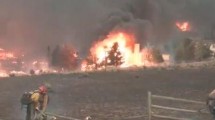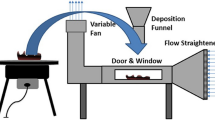Abstract
Structure ignition by wind-driven firebrand showers is an important fire spread mechanism in large outdoor fires. Experiments were conducted with three common mulch types (shredded hardwood mulch, Japanese Cypress wood chips, and pine bark nuggets) placed adjacent to realistic-scale re-entrant corners. In the first series of experiments, mulch beds were placed adjacent to a re-entrant corner constructed with wood studs and lined with oriented strand board (OSB) as the sheathing. The premise behind conducting experiments with no siding treatments applied was predicated on the notion that bare OSB mulch contact would be a worst-case scenario, and therefore, a wall assembly in the most vulnerable state to mulch ignition. In the second series of experiments, vinyl siding was applied to the re-entrant corner assemblies (wood studs/OSB/moisture barrier/vinyl siding), and the influence of vertical separation distance (102 mm or 203 mm) on wall ignition from adjacent mulch beds was determined. The vertical separation distance was maintained by applying gypsum board to the base of the re-entrant corner. The siding itself did not influence the ignition process for the mulch beds, as the mulch beds were the first to ignite from the firebrand showers. In all experiments, it was observed that firebrands produced smoldering ignition in the mulch beds, this transitioned to flaming ignition, and the re-entrant corner assembly was exposed to the flaming mulch beds. With no siding treatments applied, the flaming mulch beds ignited the re-entrant corner, and ignition was observed to propagate to the back side of re-entrant corner assembly under all wind speeds (6 m/s to 8 m/s). With respect to the re-entrant corners fitted with vinyl siding, the mulch type, vertical separation distance, and wind speed were important parameters as to whether flaming ignition was observed to propagate to the back-side of a re-entrant corner assembly. Mulches clearly pose an ignition hazard to structures in large outdoor fires.









Similar content being viewed by others
Notes
Certain commercial products are identified to fully describe the experiments. This is no way implies endorsement or recommendation from NIST.
References
Final Report, Summary, Parliament of Victoria, 2009 Victorian Bushfires Royal Commission, ISBN 978-0-9807408-1–3, July 2010
Reszka P, Fuentes A (2015) The great valparaiso fire and fire safety management in Chile. Fire Technol 51:753–758. doi:10.1007/s10694-014-0427-0
Manzello SL et al (2012) Workshop for fire structure interaction and urban and wildland-urban interface (WUI) fires—operation Tomodachi fire research. Fire Saf J 59:122–131
Foote EID (1994) Structure survival on the 1990 Santa Barbara “Paint” fire: A retrospective study of urban-wildland interface fire hazard mitigation factors, MS thesis, University of California at Berkeley, p 129
Cohen JD, Stratton RD (2008) Home destruction examination: Grass Valley Fire, Lake Arrowhead, California. Pacific Southwest Region (Region 5), Forest Service, U.S. Department of Agriculture
Maranghides A, Mell W (2011) A case study of a community affected by the witch and Guejito wildland fires. Fire Technol 47:379–420. doi:10.1007/s10694-010-0164-y
Koo E, Pagni PJ, Weise DR, Woycheese JP (2010) Firebrands and spotting ignitions in large-scale fires. Int J Wildland Fire 19:818–843
Suzuki S, et al (2015) Ignition of mulch beds exposed to continuous wind-driven firebrand showers. Fire Technol 51:905–922. doi:10.1007/s10694-014-0425-2
Beyler C, et al (2014) Development of test methods for assessing the fire hazards of landscaping Mulch. Fire Technol 50:39–60. doi:10.1007/s10694-012-0264-y
Manzello SL, Suzuki S, Nii D (2015) Proceedings of 27th annual Japan association for fire science and engineering (JAFSE), Yonezawa, Japan, Paper A38, pp 232–233
Suzuki S, et al (2015) Ignition of wood fencing assemblies exposed to continuous wind-driven firebrand showers. Fire Technol. doi:10.1007/s10694-015-0520-z
Manzello SL (2014) Enabling the investigation of structure vulnerabilities to wind-driven firebrand showers in wildland-urban interface (WUI) fires. Fire Saf Sci 11. Published on-line; see www.iafss.org
Manzello SL, Foote EID (2014) Characterizing firebrand exposure from wildland-urban interface (WUI) fires: results from the 2007 angora fire. Fire Technol 50:105–124. doi:10.1007/s10694-012-0295-4
Manzello SL, Suzuki S (2014) Exposing decking assemblies to continuous wind-driven firebrand showers. Fire Saf Sci 11. Published on-line; see www.iafss.org
Suzuki S, Manzello SL, Lage M, Laing G (2012) Firebrand generation data obtained from a full-scale structure burn. Int J Wildland Fire 21:961–968
Rissel S, Ridenour K (2013) Ember production during the Bastrop complex fire. Fire Manag Today 72:7–13
Pellegrino J, Bryner NP, Johnsson EL (2013) Wildland-urban interface (WUI) fire research needs—workshop summary report, NIST SP 1150. doi:10.6028/NIST.SP.1150
Manzello SL, Quarles SL (2015) Workshop on structure ignition in wildland-urban interface (WUI) fires, NIST SP 1198. doi:10.6028/NIST.SP.1198
ASTM Standard Test Method E2886/E2886M–14, 2014.
Suzuki S, Manzello SL (2015) Proceedings of 27th annual JAFSE symposium, paper A37, pp 230–231
Author information
Authors and Affiliations
Corresponding author
Rights and permissions
About this article
Cite this article
Manzello, S.L., Suzuki, S. & Nii, D. Full-Scale Experimental Investigation to Quantify Building Component Ignition Vulnerability from Mulch Beds Attacked by Firebrand Showers. Fire Technol 53, 535–551 (2017). https://doi.org/10.1007/s10694-015-0537-3
Received:
Accepted:
Published:
Issue Date:
DOI: https://doi.org/10.1007/s10694-015-0537-3




